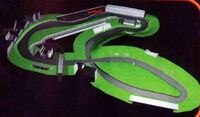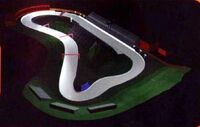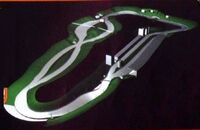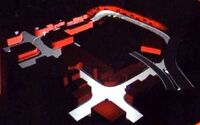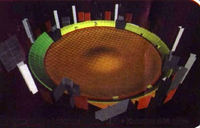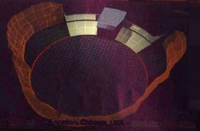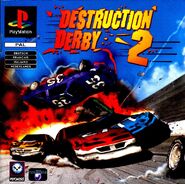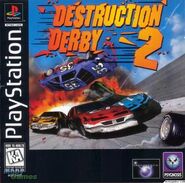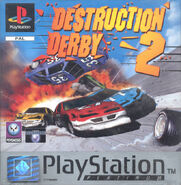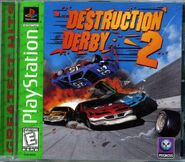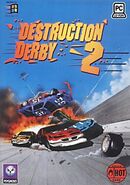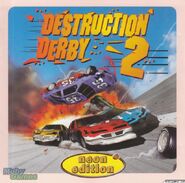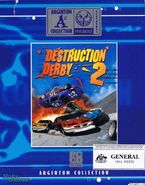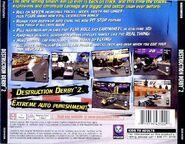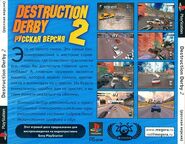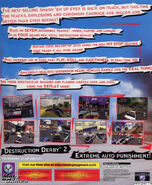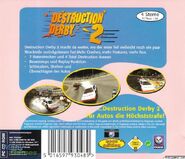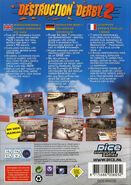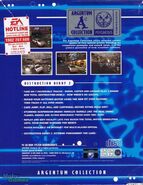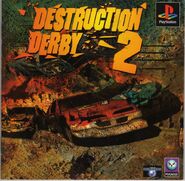(→Tracks) |
(→Covers) |
||
| Line 327: | Line 327: | ||
<gallery columns="3" spacing="small" orientation="none" captionalign="left" hideaddbutton=true> |
<gallery columns="3" spacing="small" orientation="none" captionalign="left" hideaddbutton=true> |
||
DD2.jpg|'''PlayStation PAL (Europe/Australia)''' |
DD2.jpg|'''PlayStation PAL (Europe/Australia)''' |
||
| − | DD2 NTSC.jpg|'''PlayStation NTSC-U (US) |
+ | DD2 NTSC.jpg|'''PlayStation NTSC-U (US)''' |
| ⚫ | |||
DD2 Rus front.jpeg|'''Megema release for PlayStation (Russia)''' |
DD2 Rus front.jpeg|'''Megema release for PlayStation (Russia)''' |
||
DD2 platinum.jpg|'''PlayStation PAL Platinum version''' |
DD2 platinum.jpg|'''PlayStation PAL Platinum version''' |
||
| Line 347: | Line 346: | ||
DD2 dice back.jpg|'''Dice Multi Media Europe release''' |
DD2 dice back.jpg|'''Dice Multi Media Europe release''' |
||
DD2 Argentum back.jpg|'''Argentum Collection release''' |
DD2 Argentum back.jpg|'''Argentum Collection release''' |
||
| + | </gallery> |
||
| + | |||
| + | ===Manual=== |
||
| + | <gallery columns="3" spacing="small" orientation="none" captionalign="left" hideaddbutton=true> |
||
| ⚫ | |||
</gallery> |
</gallery> |
||
<br /> |
<br /> |
||
Revision as of 01:14, 31 August 2018
| Destruction Derby 2 | |
|---|---|
 
| |
| Developer | Reflections |
| Publisher | Psygnosis |
| Original release | 1996 |
| Players | 1 player, or up to 20 players (via PC patch) |
| Ratings | ELSPA: 3+ ESRB: K-A OFLC: G USK: 6 |
| Predecessor | Destruction Derby |
| Successor | Destruction Derby Raw |
Wow, total destruction!~ commentary quote
Destruction Derby 2 is the second installment in the Destruction Derby series. It was first released in October 1996 for the PlayStation and was also ported to MS-DOS PCs. Once again the game was developed by Reflections and published by Psygnosis.
Development
The original Destruction Derby was developed in seven months, resulting in a few design flaws and the cutting of several ideas that could not be implemented within that time frame. According to producer Martin Edmondson, Destruction Derby 2 is a rewrite of the original, with only the 2D collision algorithms remaining intact. The engine was rewritten to handle the larger tracks incorporating obstacles such as hills and jumps, while the car dynamics were also redesigned. The collision routines were extended so cars can handle being flipped over. Edmondson stated that Destruction Derby 2 felt like a new game rather than merely a sequel with more tracks.[1][2]
Edmondson wanted to Americanise the game, as the original had a British banger racing feel.[2] Therefore, the cars were designed to resemble the stock cars used in NASCAR racing,[2] while all the tracks were situated in the United States.[3] Edmondson also wanted appropriate music for American stock car races, so he attended races across the United States, where he noticed that metal music featured prominently. Thrash metal bands Jug and Tuscan were therefore chosen to compose the soundtrack, as some members of the team were involved with them.[2] Because soft-spoken commentary would not fit with the soundtrack, commentator Paul Page was asked to serve as the game's announcer due to his "animated and excitable" style.[4] Edmondson travelled to the United States to record Page at a studio in Indianapolis.[2]
Variety and realism were focuses for the tracks: they featured visuals such as forests, Neon Cities, and Canyons, complete with obstacles. The team travelled to photograph the textures. The tracks were constructed in Softimage 3D and converted to PlayStation format mesh data using a custom tool.[2] In response to a common criticism of the original Destruction Derby, the tracks were designed to be larger and less narrow.[5] The team were inspired by Daytona's revolving windmills, and large jumps were implemented to add drama to the tracks. The most realistic aspect of the race tracks was the pit stop, although Edmondson stated that he limited players to one stop because the team did not want to detract from the action and because a penalty system would have added a lot of extra work. Cars nearing destruction were designed to behave in a realistic and unpredicatable fashion through effects such as losing the bonnet (hood) and catching on fire.[2]
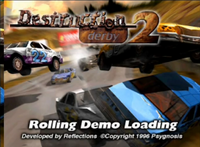
Trailer of DD2 on CD 13 Demo One of the Official UK PlayStation Magazine (SCED-00365)
Wrecking Racing was meant to enable a broad range of strategies, such as keeping up but watching out for destruction opportunities, destroying the cars in front, and destroying everything without concern for position. This was hard to balance, but it proved possible to win with each of those strategies. Edmondson came up with Stock Car Racing after watching the Banger World Finals at Arena Essex and noticing that there were some cars simply racing rather than trying to destroy each other. The normal race mode was implemented simply because the engine could support running a traditional race. For Destruction Derby mode, more varied arenas were implemented to take advantage of a new physics system developed by Reflections. Edmondson decided against implementing features such as speed boosts and collectibles because he did not want the game to feel like an arcade game and wanted the car physics to be as realistic as possible.[6]
Destruction Derby 2 was released on the PlayStation in October 1996, and a PC version soon followed.[2] Again, like its predecessor, Destruction Derby 2 was a hit and qualified for PlayStation's Platinum Range/Greatest Hits in 1997. Originally the game was released in a double-CD cover (even though the game was only on one CD), but the platinum range version was released in an ordinary cover.
PC port
The port to MS-DOS had some graphical differences. It only had 256 colours, rather than 16-bit. Some other graphical details were also missing, such as the rear lights (making the rear of a car look noticably different). One basic functionality that wasn't implemented is being able to use the keyboard letters in the name entry screen.
Sega Saturn port
A port to the Sega Saturn was under development by the British based Probe Entertainment (which was owned by Acclaim Entertainment at the time) and to be published by Perfect Entertainment or THQ in the U.S. The project was cancelled as THQ decided to pull out of the Saturn market in mid-1997,[7] and probably also as Acclaim was cutting Saturn support. Meanwhile Wipeout 2097 did eventually get a Saturn release by September. Another THQ/Perfect Entertainment game that fell victim during the Saturn conversion was Adidas Power Soccer.
A prototype of the game exists which is playable in the first track but lacks textures and other bits. The game consisted of two discs: one that handled the playable track and another 'frontend' disc for the incomplete main menu.[8] A video clip of the prototype has been on YouTube since 2011. A commenter on the video called 'Andy Lunn' claiming to be the programmer of Destruction Derby 2 for Saturn said that the game was 95% complete before it was scrapped.[9]
Release dates
- PlayStation
- NA: 31 October 1996
- EU: January 1997
- JP: 21 February 1997
- PC
- EU: 1996
- NA: 31 October 1996
- Sega Saturn
- Never released.
Matrox Mystique version
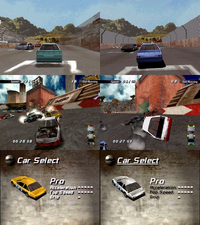
Screenshots of the software graphics (left) and on Mystique (right)
Destruction Derby 2 was also made compatible with the Matrox Mystique API for the Matrox Mystique video accelerator card. This optimised version runs at a resolution of 640x480 pixels, four times the software resolution. It was exclusively bundled with the Mystique for a month until January 1997. In a Matrox press release, head of Reflections, Martin Edmondson, commented that Destruction Derby 2 "runs very well on the Matrox Mystique."[10][11] Notably the cars now have rear lights like in the PlayStation release, and also the Amateur car is coloured yellow rather than white (and the Pro the opposite).
Multiplayer patch
On 25 April 1997, Psygnosis released a free downloadable multiplayer patch (v0.91 beta) for the PC version of Destruction Derby 2. This update gives the ability for network (IPX) and internet play for up to 20 players, or up to two via serial/modem. In addition the AI has been tweaked for "fairness" in response to criticism of opponents' aggression.[12] It is still available from the Internet Archive.[13]
Gameplay
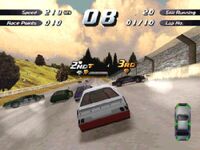
Gameplay in the first track
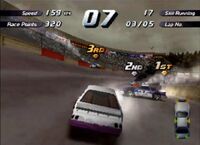
A race in Black Sail Valley
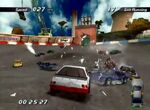
DD2
Destruction Derby 2's completely rewritten engine and new crash physics meant players could lose tyres and roofs during colliding. One of the main criticisms of Destruction Derby were its narrow, tight tracks. DD2's new engine allowed for much larger tracks and featured hills and jumps. Cars could also be flipped over now due to airbourne collisions. DD2 also puts a lot of emphasis on speed.
Critics considered Destruction Derby to be too easy, and so Reflections decided to significantly toughen up DD2. The AI has had major changes, with the opponents now considered by many to be very aggressive, which plays a large part in the increased difficulty. Combined with the newer physics that can cause harder damage, as well as its metal soundtrack, it made the gameplay in Destruction Derby 2 highly energetic.
An addition during races was the pit stop where cars can go to have damage repaired, similar to real-life NASCAR. Destruction Derby 2 also featured a commentator again, this time performed by American motorsports broadcaster Paul Page.
Damage engine
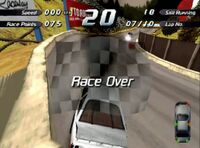
Race Over - displayed whenever you've finished, or been wrecked

The on-screen damage indicator
The damage indicator has been unchanged from Destruction Derby, except that they're smaller in size. The arrow colours of damage are still the same - from green to red to black (including several inbetween colours like orange).
Points system

Race Points
Many of the points have been retained from Destruction Derby, but has the number increased.
- Spinning an opponent's car 90° - 10 points
- Spinning an opponent's car 180° - 25 points
- Spinning an opponent's car 360° - 50 points
- Gripping an opponent's car - 25 points
Note: attacking an opponent that is already down does not net points.
Game modes
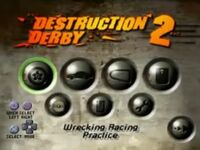
Destruction Derby 2 Main Menu
- Wrecking Racing
- Stock Car
- Championship
- Practice
- Time Trials
- Multiplayer
- Destruction Derby
- Practice
- Total Destruction
In the DD2 manual, the three main modes are referred to as race styles.
Locations
Tracks
There are seven all new tracks, of which the last three are gradually unlocked by progressing in Championship.[14]
Bowls
Four new bowls were made, replacing the single one in the original DD game.
Vehicles
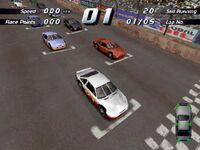
The cars of DD2

Comparison of the intro/cover art cars and in real life
Three different cars are available to the player. They have retained their old names but given completely new looks. They also no longer have a branded identity as in Destruction Derby.
The cars resemble 1995 Ford Thunderbird Nascars. The cars shown in the intro and the cover art though (with and without decals) are 1995 Pontiac Grand Prix Nascars.
Competitors
*New competitors. They replaced Crunch Bunch, The Idol, The Taxman and The Doctor from DD1.
Soundtrack
The soundtrack for the game was performed by the unsigned English thrash metal bands Jug and Tuscan.
In addition, Mike Clarke composed the music playing during the credits video clip. Interestingly this track is titled "Cold Storage", likely a reference to his co-worker Tim Wright aka CoLD SToRAGE.
| Track no. | Name | Featured in | Length | Link to YouTube |
| Slapshot | Jug | Pine Hills Raceway | 2:44 | [1] |
| Rejected | Jug | Chalk Canyon | 3:49 | [2] |
| Dead Happy | Jug | Black Sail Valley | 3:42 | [3] |
| Footsteps | Jug | Ultimate Destruction | 2:48 | [4] |
| How Do You Know? | Jug | Caprio County Raceway | 2:47 | [5] |
| Better | Jug | Liberty City | 2:15 | [6] |
| Pushed Away | Jug | SCA Motorplex | 3:34 | [7] |
| Telekenesis | Tuscan | The Colosseum | 3:47 | [8] |
| Pinnacle | Tuscan | The Pit | 3:30 | [9] |
| Little Pig | Jug | Red Pike Arena | 1:54 | [10] |
| Soundcheck | Jug | Death Bowl | 1:38 | [11] |
| Joy Rider | Jug | Main Menu | 2:52 | [12] |
| Direction | Jug | Results | 5:57 | [13] |
| Jade | Jug | End of Season | 1:52 | [14] |
| Breed | Jug | Bonus Soundtrack 1* Animated credits |
1:14 | [15] |
| Sun Dive | Tuscan | Bonus Soundtrack 2* | 3:25 | [16] |
| Burn Out | Jug | Bonus Soundtrack 3* | 3:05 | [17] |
| Crawl | Jug | Bonus Soundtrack 4* | 5:55 | [18] |
*Bonus Soundtracks are playable from the in-game 'CD player'
Reception
Template:Video game reviews
The PlayStation version received positive reviews. Edge praised the improved damage system resulting from the new physical modelling routines, saying the crashes are much more intense than the original. The 3D engine was described as "impressive", but the lack of a link-up multiplayer mode was criticised.[15] Next Generation commented, "As with most ground-breaking titles ... Destruction Derby created as many new problems as solutions, and the developers of Destruction Derby 2 have done an extremely nice job of correcting these faults with a much improved sequel." The reviewer elaborated that the game's larger tracks than the original allow the player to both build up more momentum for crashes and enjoy more of a conventional racing challenge, and that the added ability for cars to leave the ground enables true 3D crashes.[16] Electronic Gaming Monthly's two sports reviewers also praised the larger tracks and improved crashes, and both assessed it as "Better in every way than the first game".[17] Jeff Kitts of GameSpot also extensively praised the improved crashes and new tracks: "The winding, narrow, claustrophobic roadways of the first Destruction Derby have been replaced with huge, wide superspeedways worthy of games like NASCAR Racing and The Need for Speed." He remarked that the slippery road surfaces make the game more difficult to play, but considered it overall a major improvement over the first game.[18] Johnny Ballgame of GamePro likewise stated that "The original Destruction Derby looks like a mere hubcap compared to the gold-rimmed gameplay and trunkful of new features of Destruction Derby 2." He cited the longer tracks, arena mode, and light sourcing, but gave the game less than perfect scores as he found the announcer grating and judged the worsened steering after crashes to inordinately favor realism over enjoyment.[19] Ed Lomag of Computer and Video Games lauded the improved car mechanics and track design and also liked that the UK PAL version runs in full screen at a full frame rate, thus proving British developers could make decent British PlayStation games. Despite these compliments, he criticised the game's limited re-playability.[20] The Electric Playground complimented the scenery and damage effects.[21] wikipedia:Game Revolution described the Stock Car Racing as "almost perfect", and the tracks as "extremely cool", but criticised the steering sensitivity.[22] Absolute PlayStation described the game as a "vast improvement" over the original, but said the gameplay is identical and "rather shallow".[23] IGN believed that the game compensates too much for the lack of difficulty of the first game through an overly aggressive AI and by making it "impossible" to catch up with the other cars. Despite this, they praised the car physics and graphics.[24] Jeuxvideo.com praised the playability of the game and the soundtrack, but criticised the commentary as "repetitive".[25] Gamezilla's Mark Skorupa described the graphics as "top notch", but also said that it breaks what was good in the original game.[26] Andrew Collins of the Official UK PlayStation Magazine believed the features are "massively improved" over the original, and said its "superbly polished" gameplay made it one of the best PlayStation racing games. His main criticism was that he thought the Destruction Derby Practice mode can make players complacent.[27] Ultra Game Players said about DD2 "This game is first-rate fun and is a must-have on your holiday wish list".[28]
The PC version did not fare as well. Rick Broida of Computer Gaming World criticised the lack of multiplayer, the high system requirements, and the difficulty. Despite these criticisms, he complimented the improved graphics and tracks over the original.[29] Sean Anderson of Gamezilla criticised the way the game handles multiplayer and described the commentator as "annoying".[30] Frederick Claude of Coming Soon Magazine compared the PC version to the PlayStation version and believed the PC version's multiplayer support via DirectPlay to be an improvement over the PlayStation version's multiplayer. For the graphics, he described the PlayStation version as "far more beautiful" than the PC version and criticised the SVGA graphics mode for its high system requirements.[31] Tim Soete of GameSpot described the PC version's graphics as an improvement over those of the original, but not as good as the PlayStation version. He also criticised the cars for being "impossible" to overtake.[32] Craig Majaski of Gamer's Zone complimented the sound and music, describing them as "top-notch", but criticised the difficulty, saying the computer cars are "almost impossible" to beat. He described Destruction Derby 2 as "an average game that could have been an excellent title".[33] Thierry Falcoz of Génération 4 in France said that Reflections made the mistake of sacrificing playability for "non-progressive" difficulty, which took pleasure from crashing into opponents away because they disappear "to the horizon" and are not seen again.[34] Germany's PC Games magazine in its January 1997 issue said that the graphics were good and that the tracks were well-designed, but criticised the lack of multiplayer. It also said that as a stock car simulation, DD2 works well, but as an action game it is far too difficult.
Covers
Front
Back
Manual
References
- ↑ "Destruction Derby 2". Edge (Bath: Future plc) (34): 34, 35. July 1996. ISSN 1350-1593.
- ↑ 2.0 2.1 2.2 2.3 2.4 2.5 2.6 2.7 "The Making Of: Destruction Derby 2". Retro Gamer (Bath: Future plc) (163): 76–79. ISSN 1742-3155.
- ↑ Manual, pp. 19–21.
- ↑ Manual, p. 29.
- ↑ "Destruction Derby 2". Next Generation (Imagine Media) (17): 54. May 1996.
- ↑ This section is mostly credited to Adam9007 on Wikipedia
- ↑ Ultra Game Players (100): 14.
- ↑ Template:Cite web url=https://web.archive.org/web/20080507034319/http://segadatabase.net/segafreak/dd2.htm
- ↑ Saturn Destruction Derby 2 Prototype. Sega Saturn UK (on YouTube).
- ↑ Matrox News (23 December 1996).
- ↑ This section's information is credited to user 'vetz' from VOGONS.org (https://www.vogons.org/viewtopic.php?p=268586)
- ↑ Destruction Derby 2 Multiplayer Upgrade. Psygnosis (28 April 1997).
- ↑ https://archive.org/details/DD2NET
- ↑ Much of the information about tracks is credited to Skullbird11 on Wikipedia
- ↑ Cite error: Invalid
<ref>tag; no text was provided for refs namedEdgeRev - ↑ "Smashing the Mold". Next Generation (Imagine Media) (25): 172. January 1997.
- ↑ Cite error: Invalid
<ref>tag; no text was provided for refs namedEGM89 - ↑ Cite error: Invalid
<ref>tag; no text was provided for refs namedGSPS - ↑ "PlayStation ProReview: Destruction Derby 2". GamePro (IDG) (100): 88. January 1997.
- ↑ Cite error: Invalid
<ref>tag; no text was provided for refs namedCVGRev - ↑ Cite error: Invalid
<ref>tag; no text was provided for refs namedEPRev - ↑ Cite error: Invalid
<ref>tag; no text was provided for refs namedGRRev - ↑ Cite error: Invalid
<ref>tag; no text was provided for refs namedABSPSRev - ↑ Cite error: Invalid
<ref>tag; no text was provided for refs namedIGNRev - ↑ Cite error: Invalid
<ref>tag; no text was provided for refs namedJVRev - ↑ Cite error: Invalid
<ref>tag; no text was provided for refs namedGZPSRev - ↑ Cite error: Invalid
<ref>tag; no text was provided for refs namedPSMRev - ↑ Cite error: Invalid
<ref>tag; no text was provided for refs namedPsygnosis - ↑ Cite error: Invalid
<ref>tag; no text was provided for refs namedCGWRev - ↑ Cite error: Invalid
<ref>tag; no text was provided for refs namedGZPCRev - ↑ Cite error: Invalid
<ref>tag; no text was provided for refs namedCSMRev - ↑ Cite error: Invalid
<ref>tag; no text was provided for refs namedGSRev - ↑ Cite error: Invalid
<ref>tag; no text was provided for refs namedGamerZRev - ↑ Cite error: Invalid
<ref>tag; no text was provided for refs namedG4Rev - ↑ This section is mostly credited to Adam9007 on Wikipedia
Credits
- Game Concept
- Martin Edmondson
- Production
- Martin Edmondson
- Producer
- Tony Parkes
- Head Programmer
- Michael Troughton
- Programmers
- James Parr, Russell Lazzari, Tony Roberts, William Musson
- 3D Modellers
- Shaun Stephenson, Matthew Gibson, Chris Williams
- Artists
- Phil Baxter, Richard Beston, David Taylor, Aidan Wilson, Jonathan Steele, Shaun Stephenson, Matt Gibson, Chris Williams
- Character Artist
- Jonathan Steele
- Track Design
- Phil Baxter
- In Game Commentary
- Paul Page




